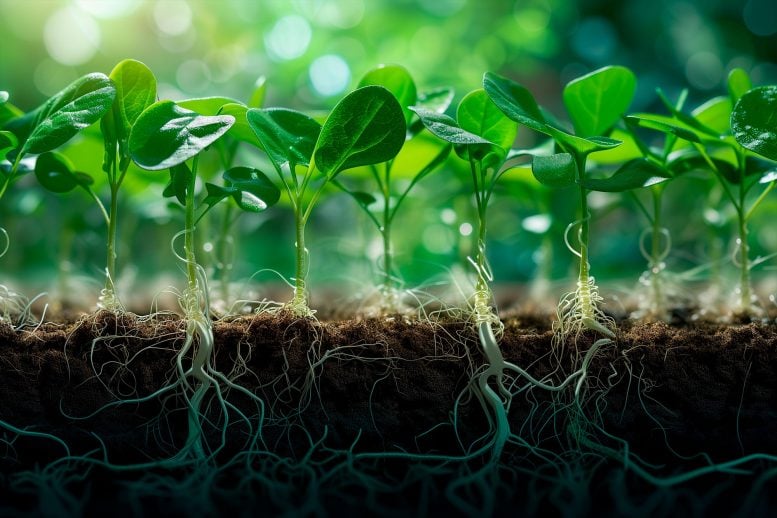How Plants Obtain Nitrogen by Supplying Iron to Symbiotic Bacteria
A recent study on leguminous plants has uncovered the role of IRON MAN (IMA) peptides in facilitating the collection of iron into root nodules during rhizobial symbiosis. This process is vital for nitrogen fixation, a key aspect of plant growth and nitrogen homeostasis. Credit: SciTechDaily.com
IMA peptides in legumes enhance iron acquisition for nitrogen fixation, offering insights into sustainable agriculture practices.
Leguminous plants have a mechanism (rhizobial symbiosis) to efficiently acquire nitrogen, which is an essential macronutrient for growth, through the nitrogen-fixing bacteria rhizobia. Root nodules are organs on plant roots that facilitate the symbiotic relationship. Rhizobia colonizes these nodules and fix nitrogen by converting nitrogen from air into ammonia. Iron is needed for the enzymes that catalyze nitrogen fixation; however, where and how iron is transported to the nodule and used for nitrogen fixation is largely unknown.
Discovering the Role of IMA Peptides
In this study, using the legume model plant Lotus japonicus, a transcriptome analysis was performed based on the nitrogen status in the plant body during the rhizobial symbiosis process. IRON MAN (IMA) peptides consisting of approximately 50 amino acids were identified, which function systemically (shoot and root systems) to collect iron into the nodules following rhizobial infection.
Insights from Comparative Analysis
Furthermore, the function of IMA peptides was analyzed in L. japonicus and Arabidopsis thaliana, a plant devoid of rhizobial symbiosis. In both plant species, the IMA peptides maintained nitrogen homeostasis by obtaining iron in response to increased nitrogen concentrations in the plant body, thereby regulating plant growth.
The research group previously identified a mechanism for regulating rhizobial symbiosis in response to the presence of nitrogen in the soil. This study builds on previous studies by clarifying the underlying mechanism of iron acquisition in response to nitrogen, which provides further insight into the mechanisms of plant adaptation to the environment.
Contributions to Sustainable Agricultural Practices
These findings are promising for the development of new technologies that contribute to a sustainable society by maximizing the capacity of plants for microbial symbiosis in terms of nutrient use.
Reference: “IMA peptides regulate root nodulation and nitrogen homeostasis by providing iron according to internal nitrogen status” by Momoyo Ito, Yuri Tajima, Mari Ogawa-Ohnishi, Hanna Nishida, Shohei Nosaki, Momona Noda, Naoyuki Sotta, Kensuke Kawade, Takehiro Kamiya, Toru Fujiwara, Yoshikatsu Matsubayashi and Takuya Suzaki, 29 January 2024, Nature Communications.
DOI: 10.1038/s41467-024-44865-4
This research was supported by Ministry of Education, Culture, Sports, Science and Technology KAKENHI grants (JP20H05908 and JP23H02495 to T.S.); JSTMirai Program (JPMJMI20E4) to T.S.

A recent study on leguminous plants has uncovered the role of IRON MAN (IMA) peptides in facilitating the collection of iron into root nodules during rhizobial symbiosis. This process is vital for nitrogen fixation, a key aspect of plant growth and nitrogen homeostasis. Credit: SciTechDaily.com
IMA peptides in legumes enhance iron acquisition for nitrogen fixation, offering insights into sustainable agriculture practices.
Leguminous plants have a mechanism (rhizobial symbiosis) to efficiently acquire nitrogen, which is an essential macronutrient for growth, through the nitrogen-fixing bacteria rhizobia. Root nodules are organs on plant roots that facilitate the symbiotic relationship. Rhizobia colonizes these nodules and fix nitrogen by converting nitrogen from air into ammonia. Iron is needed for the enzymes that catalyze nitrogen fixation; however, where and how iron is transported to the nodule and used for nitrogen fixation is largely unknown.
Discovering the Role of IMA Peptides
In this study, using the legume model plant Lotus japonicus, a transcriptome analysis was performed based on the nitrogen status in the plant body during the rhizobial symbiosis process. IRON MAN (IMA) peptides consisting of approximately 50 amino acids were identified, which function systemically (shoot and root systems) to collect iron into the nodules following rhizobial infection.
Insights from Comparative Analysis
Furthermore, the function of IMA peptides was analyzed in L. japonicus and Arabidopsis thaliana, a plant devoid of rhizobial symbiosis. In both plant species, the IMA peptides maintained nitrogen homeostasis by obtaining iron in response to increased nitrogen concentrations in the plant body, thereby regulating plant growth.
The research group previously identified a mechanism for regulating rhizobial symbiosis in response to the presence of nitrogen in the soil. This study builds on previous studies by clarifying the underlying mechanism of iron acquisition in response to nitrogen, which provides further insight into the mechanisms of plant adaptation to the environment.
Contributions to Sustainable Agricultural Practices
These findings are promising for the development of new technologies that contribute to a sustainable society by maximizing the capacity of plants for microbial symbiosis in terms of nutrient use.
Reference: “IMA peptides regulate root nodulation and nitrogen homeostasis by providing iron according to internal nitrogen status” by Momoyo Ito, Yuri Tajima, Mari Ogawa-Ohnishi, Hanna Nishida, Shohei Nosaki, Momona Noda, Naoyuki Sotta, Kensuke Kawade, Takehiro Kamiya, Toru Fujiwara, Yoshikatsu Matsubayashi and Takuya Suzaki, 29 January 2024, Nature Communications.
DOI: 10.1038/s41467-024-44865-4
This research was supported by Ministry of Education, Culture, Sports, Science and Technology KAKENHI grants (JP20H05908 and JP23H02495 to T.S.); JSTMirai Program (JPMJMI20E4) to T.S.
